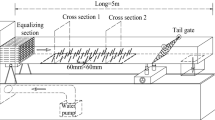Abstract
The characteristics of the roughness coefficient are very important for practical application. Some experiments are conducted to study the variation of Manning’s n with flow depth, mean velocity, and density of vegetation,. An assumed velocity distribution to describe the vegetative flow of submerged vegetation is confirmed by experimental results. The measured velocities in this study seem to have little effect on the curve of n ~ h, and a new linear relationship between Manning’s n and flow depths is observed clearly. According to the arguments that the flow resistance of densely unsubmerged vegetation is dominated by the resistance exerted on vegetations, the influence of the density of vegetation on Manning’s n is estimated. On the basis of the velocity distribution, the n ~ h curve under submerged condition is theoretically obtained from the n ~ h curve under unsubmerged condition. These results are also well confirmed by experimental results and very significant for practical applications.
Similar content being viewed by others
References
KADLEC R. H. Overland flow in wetlands: vegetation resistance[J]. Journal of Hydraulic Engineering, 1990, 116(5): 691–706.
CHOW V. T. Open-channel hydraulics[M]. New York: Mc Graw-Hill, 1959.
REE W. O. Retardation coefficients for row crops in diversion terraces[J]. Transactions of the American Society of Agricultural Engineers, 1958, 1: 78–80.
KOUWEN N., LI R. M. and SIMONS D. B. Flow retardance in vegetated waterways[J]. Trans., ASAE, 1981, 24(3): 684–698.
WILSON C. A. M. E. and HORRITT M. S. Measuring the flow resistance of submerged grass[J]. Hydrol. Process, 2002, 16(13): 2589–2598.
TEMPLE and DARREL M. Velocity distribution coefficients for grass-line channels[J]. Journal of Hydraulic Engineering, 1986, 112(3): 193–205.
PETRYK S. and BOSMAJIAN M. G. Analysis of flow through vegetation[J]. Proc., ASCE, 1975, 101(7): 871–884.
JAMES C. S., BIRKHEAD A. L. and JORDANOVA A. A. Flow resistance of emergent vegetation[J]. Journal of Hydraulic Research, 2004, 42(4): 390–398.
FATHI-MAGHADAM M. and KOUWEN N. nonrigid, nonsubmerged, vegetative roughness on floodplains[J]. Journal of Hydraulic Engineering, 1997, 123(1): 51–57.
KOUWEN N., UNNY T. E. and HILL H. M. Flow retardance in vegetated channels[J]. J. Irrig. Drain. Div. Am. Soc. Civ. Eng., 1969, 95(2): 329–342.
WU F. C., SHEN H. W. and CHOU Y. J. Variation of roughness coefficients for unsubmerged and submerged vegetation[J]. Journal of Hydraulic Engineering, 1999, 125(9): 934–942.
KUTIJA V. and HONG H. T. M. A Numerical model for assessing the additional resistance to flow introduced by flexible vegetation[J]. Journal of Hydraulic Research, 1996, 34(1): 99–114.
CAROLLO F. G., FERRO V. and TERMINI D. Flow velocity measurements in vegetated channels[J]. Journal of Hydraulic Engineering, 2002, 128(7): 664–673.
ROWINSKI Pawel M. and KUBRAK Janusz et al. A mixing-length model for predicting vertical velocity distribution in flows through emergent vegetation[J]. Hydrological Sciences Journal, 2002, 47(6): 893–904.
IKEDA S. and BARAZAWA M. Three-dimensional organized vortices above flexible water plants[J]. Journal of Hydraulic Engineering, 1996, 122(11): 634–640.
LI Yan-hong and ZHAO Min. Experimental studies of hydrodynamics in vegetated river flows-vertical profiles of velocity, shear velocity and Manning roughness[J]. Journal of Hydrodamics, Ser. A, 2004, 19(4): 513–519(in Chinese).
MORRIS H. M. Flow in rough conduits[J]. Trans., ASCE, 1955, 120: 373–410.
NI Han-gen and GU Feng-feng. Roughness coefficient of non-submerged reed[J]. Journal of Hydrodamics, Ser. A, 2005, 20(2): 167–173(in Chinese).
Author information
Authors and Affiliations
Corresponding author
Additional information
Project supported by the National Natural Science Foundation of China (Grant No.50139029) and the Chinese Offshore Investigation and Assessment 908 (PJ9: Study on effect of the Yangtze estuary flow field to the important sea project of shanghai).
Biography: Gu Feng-feng(1978-), Male, Ph. D.
Rights and permissions
About this article
Cite this article
Gu, Ff., Ni, Hg. & Qi, Dm. Roughness Coefficient for Unsubmerged and Submerged Reed. J Hydrodyn 19, 421–428 (2007). https://doi.org/10.1016/S1001-6058(07)60135-8
Received:
Revised:
Published:
Issue Date:
DOI: https://doi.org/10.1016/S1001-6058(07)60135-8




